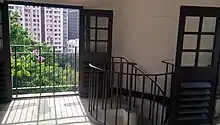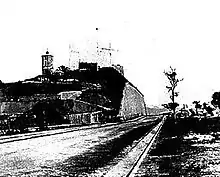Blackhead Point
Blackhead Point (Chinese: 黑頭山; lit. 'black head hill'), also known as Tai Pau Mai (大包米) indigenously, or by the names Tsim Sha Tsui Point and Signal Hill (訊號山), was a cape before any land reclamation took place in Tsim Sha Tsui, Kowloon, Hong Kong. It currently remains a small hill near the coast.
| Signal Hill Garden | |
|---|---|
| 訊號山花園 | |
 Aerial view | |

| |
| Location | Tsim Sha Tsui, Kowloon |
| Area | 1.3 hectares |
| Opened | 1974 |
| Operated by | Leisure and Cultural Services Department |
| Open | Year round |
| Public transit access | Tsim Sha Tsui Station |
Etymology
Blackhead Point was named after a German businessman in Hong Kong named Friedrich Johan Berthold Schwarzkopf,[1] who naturalised as a British citizen and anglicised his name as Blackhead.[2]
Signal Hill Tower

The Signal Hill Tower (訊號塔) was built in the Edwardian style in 1907 at the top of the hill.[3] It was originally a three-storey building. The tower stood at 12.8 metres (42 feet) tall, with a red brick facade. Then, another storey was added to the structure in 1927 for clearer view of the tower from incoming vessels, this heightened it to 18.9 m (62 ft).[4] The windows of the added storey features round windows whereas the original floors have square windows. Prior to the addition, the roof of the building was flat. A dome-shaped roof painted light green was built in replacement. There was a 5.5 m long mast which used to contain the time ball atop the building.


The purpose of the tower was to house a time ball apparatus of the Hong Kong Observatory previously located in the nearby Marine Police Headquarters Compound.[5] The apparatus operated in the building from January 1908 to June 1933, dropping once daily from 1908 to 1920, and twice a day from 1920 to 1933. The dropping of the time ball ceased on 30 June 1933 as the building itself was in disrepair, short of staff, and the method used to check the marine chronometers had become obsolete, in comparison with radio-telegraphy and telephony.[6] The Urban Council restored the tower in the 1970s.[7]
The building was designated a Grade II historic building in 1981 and was upgraded to a Grade I historic building on December 18, 2009. On 23 October 2015 the tower was also declared a monument.[4]
Today
The site was allocated to the Urban Council in 1973 and made a park, called the Signal Hill Garden, which was officially opened on 20 August 1974.[8] Signal Hill Tower is still standing and was listed as a Grade II historic building[9] in 1981,[6] and as a Grade I historic building since 2009.[10] A small building in the park, now repurposed as a toilet, was where typhoon signals were hoisted in Hong Kong as it was located on the highest hill near the middle of Victoria Harbour. The entrance of the park is at Minden Row.
The Signal Hill Garden is adjacent to the Middle Road Children's Playground. However, the two parks are not contiguous and one cannot walk to the other without first exiting to the street. Note that the open hours (for 2019) for the Tower is: 9:00 am - 11:00 am and 4:00 pm - 6:00 pm daily.
Gallery
- Signal Hill Garden
 Signal Hill Tower and the timeball before the additional storey was added
Signal Hill Tower and the timeball before the additional storey was added The time ball tower in 1908.
The time ball tower in 1908.
References
- Davies, Stephen (19 July 2017). Strong to Save: Maritime Mission in Hong Kong from Whampoa Reach to the Mariners' Club. City University of HK Press. ISBN 9789629373054.
- Wordie, Jason (2007). Streets: Exploring Kowloon. Hong Kong University Press. ISBN 9789622098138.
- East Rail Extension - Hung Hom to Tsim Sha Tsui
- "Three historic buildings declared monuments (with photos)". Hong Kong Government. 23 October 2015.
- History of Hong Kong Time Service
- Brief Information on Proposed Grade I Items. Item #47 Archived 2012-10-13 at the Wayback Machine
- "Signal Hill Garden". Urban Council. 5 July 1979. Missing or empty
|url=(help) - "Monthly Publicity Report". Urban Council. 17 September 1974. Missing or empty
|url=(help) - List of Graded Historic Buildings in Hong Kong Archived 2011-07-09 at the Wayback Machine (as at 18 September 2009)
- List of the 1,444 Historic Buildings in Building Assessment (as of 27 December 2013)